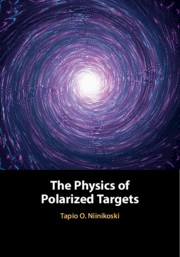Book contents
- The Physics of Polarized Targets
- The Physics of Polarized Targets
- Copyright page
- Dedication
- Contents
- Preface
- Acknowledgements
- 1 Introduction to Spin, Magnetic Resonance and Polarization
- 2 Resonance and Relaxation of Interacting Spin Systems
- 3 Electron Paramagnetic Resonance and Relaxation
- 4 Dynamic Nuclear Polarization
- 5 Nuclear Magnetic Resonance and Relaxation
- 6 NMR Polarization Measurement
- 7 Polarized Target Materials
- 8 Refrigeration
- 9 Microwave and Magnet Techniques
- 10 Other Methods of Nuclear Spin Polarization
- 11 Design and Optimization of Polarized Target Experiments
- Appendices
- Index
- References
2 - Resonance and Relaxation of Interacting Spin Systems
Published online by Cambridge University Press: 03 February 2020
- The Physics of Polarized Targets
- The Physics of Polarized Targets
- Copyright page
- Dedication
- Contents
- Preface
- Acknowledgements
- 1 Introduction to Spin, Magnetic Resonance and Polarization
- 2 Resonance and Relaxation of Interacting Spin Systems
- 3 Electron Paramagnetic Resonance and Relaxation
- 4 Dynamic Nuclear Polarization
- 5 Nuclear Magnetic Resonance and Relaxation
- 6 NMR Polarization Measurement
- 7 Polarized Target Materials
- 8 Refrigeration
- 9 Microwave and Magnet Techniques
- 10 Other Methods of Nuclear Spin Polarization
- 11 Design and Optimization of Polarized Target Experiments
- Appendices
- Index
- References
Summary
We shall first outline the types of interactions of spins, which are most important for solid polarized targets: the magnetic dipole interaction, the quadrupole interaction, the spin-orbit interaction and the hyperfine interaction. Other direct and indirect spin interactions are described: these give rise to the chemical shift, the Knight shift, molecular spin isomers and to the exchange interaction of electron pairs. These, and in particular the dipolar interaction, are then used in the discussion of the magnetic resonance phenomena, such as the resonance line shape and saturation. The magnetic resonance absorption and the transverse susceptibility are discussed starting from the first principles, and Provotorov's equations are derived. The relaxation of spins, which is phenomenologically introduced already for the saturation, is then overviewed in greater depth, before closing with sudden and adiabatic changes of spin systems in the rotating frame.
Keywords
Information
- Type
- Chapter
- Information
- The Physics of Polarized Targets , pp. 43 - 97Publisher: Cambridge University PressPrint publication year: 2020
